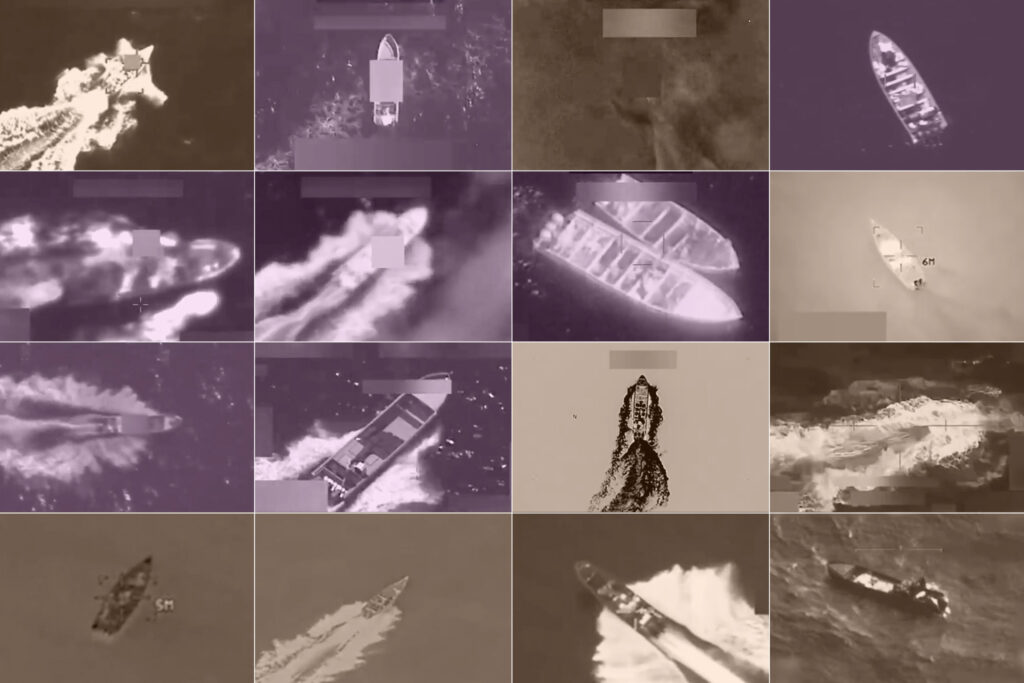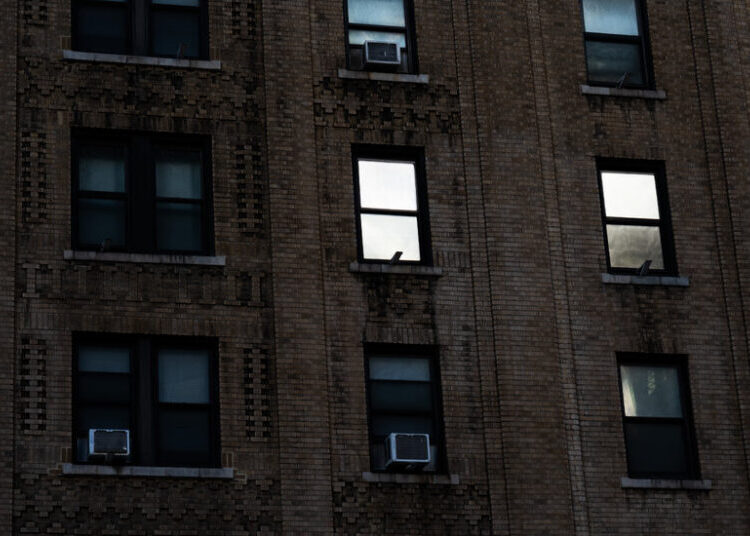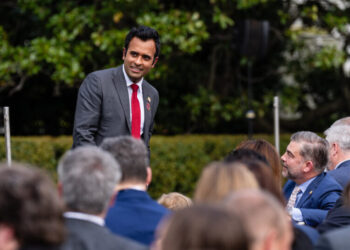The longer the U.S. surveillance aircraft followed the boat, the more confident intelligence analysts watching from command centers became that the 11 people on board were ferrying drugs.
Defense Secretary Pete Hegseth gave a verbal directive, according to two people with direct knowledge of the operation. “The order was to kill everybody,” one of them said.
A missile screamed off the Trinidad coast, striking the vessel and igniting a blaze from bow to stern. For minutes, commanders watched the boat burning on a live drone feed. As the smoke cleared, they got a jolt: Two survivors were clinging to the smoldering wreck.
The Special Operations commander overseeing the Sept. 2 attack — the opening salvo in the Trump administration’s war on suspected drug traffickers in the Western Hemisphere — ordered a second strike to comply with Hegseth’s instructions, two people familiar with the matter said. The two men were blown apart in the water.
Hegseth’s order, which has not been previously reported, adds another dimension to the campaign against suspected drug traffickers. Some current and former U.S. officials and law-of-war experts have said that the Pentagon’s lethal campaign — which has killed more than 80 people to date — is unlawful and may expose those most directly involved to future prosecution.
The alleged traffickers pose no imminent threat of attack against the United States and are not, as the Trump administration has tried to argue, in an “armed conflict” with the U.S., these officials and experts say. Because there is no legitimate war between the two sides, killing any of the men in the boats “amounts to murder,” said Todd Huntley, a former military lawyer who advised Special Operations forces for seven years at the height of the U.S. counterterrorism campaign.
Even if the U.S. were at war with the traffickers, an order to kill all the boat’s occupants if they were no longer able to fight “would in essence be an order to show no quarter, which would be a war crime,” said Huntley, now director of the national security law program at Georgetown Law.
This report is based on interviews with and accounts from seven people with knowledge of the Sept. 2 strike and the overall operation.
Chief Pentagon spokesman Sean Parnell declined to address questions about Hegseth’s order and other details of the operation, including Special Operations involvement. “This entire narrative is completely false,” he said in a statement. “Ongoing operations to dismantle narcoterrorism and to protect the Homeland from deadly drugs have been a resounding success.”
The elite counterterror group SEAL Team 6 led the attack, according to four people with direct knowledge of the matter, who spoke on the condition of anonymity because of the ongoing sensitive operations.
The commander overseeing the operation from Fort Bragg in North Carolina, Adm. Frank M. “Mitch” Bradley, told people on the secure conference call that the survivors were still legitimate targets because they could theoretically call other traffickers to retrieve them and their cargo, according to two people. He ordered the second strike to fulfill Hegseth’s directive that everyone must be killed.
Later in the day, President Donald Trump released a redacted 29-second surveillance drone video showing the attack. The video does not include any footage of the subsequent strike on the survivors.
In the weeks following that attack, the Trump administration notified Congress that the U.S. was in a “non-international armed conflict” with “designated terrorist organizations,” supported by an opinion from the Justice Department’s Office of Legal Counsel that asserted that because the U.S. was in an armed conflict, personnel taking part in military strikes who were following orders consistent with the laws of war would not be exposed to prosecution.
“That’s one of the problems with the law of armed conflict — the state using force is judge, jury and executioner,” Huntley said.
Since that first attack, the Pentagon has hit at least 22 more boats, including one semisubmersible, in the Caribbean Sea and eastern Pacific Ocean, killing another 71 alleged drug smugglers, according to officials and internal data seen by The Washington Post.
A clandestine strike
At the time of the Sept. 2 strike, Bradley headed Joint Special Operations Command, or JSOC, tasked with the military’s most sensitive and dangerous missions, often working with counterparts in the CIA. Since then, Bradley has been promoted to lead U.S. Special Operations Command, JSOC’s parent organization, which oversees elite units across the military.
SEAL Team 6, known formally as Naval Special Warfare Development Group and under JSOC command, conducted the intelligence collection and targeting for this attack and several others, according to two people.
The protocols were changed after the strike to emphasize rescuing suspected smugglers if they survived strikes, according to three people. It is unclear who directed the change in protocol and when exactly it took shape.
In one Oct. 16 strike in the Atlantic Ocean that killed two, another two men were captured and repatriated to Colombia and Ecuador. In a series of strikes on four boats in the eastern Pacific on Oct. 27 that killed 14 men, one apparent survivor was left to the Mexican Coast Guard to retrieve. The body was never found.
If the video of the blast that killed the two survivors on Sept. 2 were made public, people would be horrified, said one person who watched the live feed.
The Intercept first reported that the survivors were killed in a follow-up attack.
In briefing materials provided to the White House, JSOC reported that the “double-tap,” or follow-on strike, was intended to sink the boat and remove a navigation hazard to other vessels — not to kill survivors, according to another person who saw the report.
A similar explanation was given to lawmakers in two closed-door briefings, according to two congressional aides. That explanation has prompted frustration among some members of Congress who say they believe the Pentagon was deceptive in its description of events, the aides said.
“The idea that wreckage from one small boat in a vast ocean is a hazard to marine traffic is patently absurd, and killing survivors is blatantly illegal,” said Rep. Seth Moulton (D-Massachusetts), a Marine Corps veteran and vocal Trump critic who received a classified briefing from Pentagon officials on the strikes in late October with other members of the House Armed Services Committee. “Mark my words: It may take some time, but Americans will be prosecuted for this, either as a war crime or outright murder.”
The boat in the first strike was hit a total of four times, twice to kill the crew and twice more to sink it, four people familiar with the operation said.
In subsequent strikes on alleged traffickers that left no survivors, the U.S. military has also fired multiple missiles to remove boats from the waterways, several people familiar with the matter said.
A new lethal modus operandi
The Pentagon’s lethal campaign marks a significant and controversial departure from U.S. counterdrug missions in the Western Hemisphere over the last several decades. Typically, Coast Guard ships and personnel have interdicted and boarded vessels believed to be trafficking, confiscating the narcotics and detaining the suspects for further prosecution.
Other agencies, such as the Drug Enforcement Administration, have relied on informants and court cases to better understand how drugs flow from South America into the United States.
Officials have said the current strikes are carried out after monitoring the movement of boats and people, and target suspects only where there is high confidence they are trafficking drugs.
Speaking a day after the first strike, Hegseth told Fox News, he watched the “live” video feed. “We knew exactly who was in that boat. We knew exactly what they were doing, and we knew exactly who they represented. And that was Tren de Aragua, a narcoterrorist organization designated by the United States, trying to poison our country with illicit drugs.”
But in classified briefings to members of Congress, Pentagon officials have not provided any specific names of traffickers or syndicate leaders they have targeted, lawmakers have said, nor have they publicly released further information beyond surveillance videos of the strikes themselves.
Current and former officials within the U.S. military and DEA have expressed doubt that all 11 people aboard the first vessel were complicit in trafficking.
The boat in question, a go-fast vessel with four motors, is common in the region and would typically be manned by a small crew — perhaps one mechanic, a driver or two, and another person focused on security, one DEA official said.
More people on board means less room for drugs to sell, the official explained. He assessed that the 11 people may have been a mix of drug runners and illegally trafficked migrants. Colombia’s president has accused the U.S. in at least one instance of killing an innocent fisherman.
Trump and the Pentagon said the Sept. 2 strike targeted members of the Venezuelan gang Tren de Aragua but have not provided evidence to support those claims. In subsequent strikes, the administration has referred to the alleged smugglers as members of “designated terrorist organizations” — a blanket term that lacks detail.
There are also gaps in the videos the administration has released of the strikes. Some show little beyond an initial violent explosion. There has been no public release of a subsequent strike video, and the Pentagon has not fulfilled a bipartisan requestfrom lawmakers to see unedited footage — making it impossible to verify any of the administration’s claims.
The lack of transparency is a major obstacle to government accountability for its use of force, Huntley said. “Really the only oversight,” he said, “is public and political pressure.”
Noah Robertson, Tara Copp, Aaron Schaffer, Meg Kelly and Dan Lamothe contributed to this report, along with Samantha Schmidt in Bogotá and Samuel Oakford in New York.
The post Hegseth order on first Caribbean boat strike, officials say: Kill them all appeared first on Washington Post.




